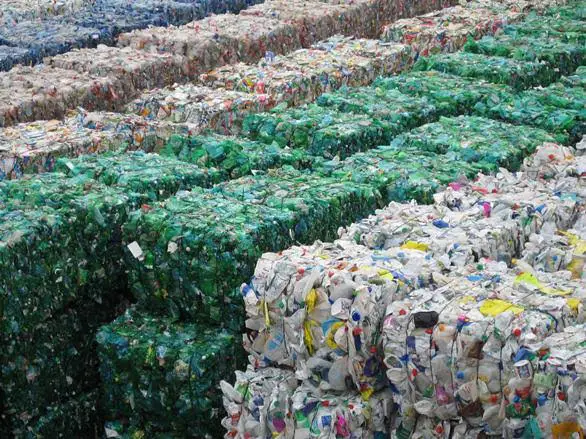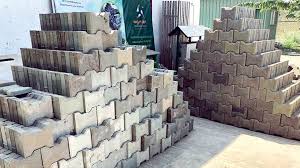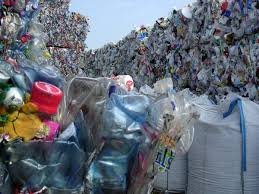Wastes into landscaping tiles? Yes plastic containers (LDPE) wastes can be turned into landscaping tiles, which helps the environment and makes our surroundings look beautiful. When we throw away plastic containers, they can harm the environment because they don’t break down easily. But if we recycle them into landscaping tiles, we give them a new life and keep them out of landfills.
Landscaping tiles made from LDPE plastic waste are sturdy and durable. They can withstand different weather conditions, like rain and sun, without getting damaged easily. This means they can be used to decorate outdoor spaces like gardens, parks, and pathways, making them look nicer while also reducing the amount of plastic waste in the environment.
To make landscaping tiles from LDPE plastic waste, the plastic containers are first collected and sorted. Then, they are cleaned and shredded into small pieces. These pieces are melted down and molded into the shape of tiles. Once the tiles are formed, they are cooled and ready to be used for landscaping.
Using LDPE plastic waste for landscaping tiles is a great way to reduce pollution and conserve resources. Instead of letting plastic containers sit in landfills for years, we can repurpose them into something useful and beautiful. By choosing products made from recycled materials, we can all play a part in protecting the environment and creating a cleaner, greener world for future generations.
Read Also: Practical Steps to Convert Plastic Containers (PVC) Wastes into Decking
Types of Recyclable Plastic Containers (LDPE) Wastes and their Uses

Recyclable plastic containers made from LDPE (Low-Density Polyethylene) come in various forms, each with its own uses and applications:
1. Bottles and Jugs: LDPE bottles and jugs are commonly used for packaging household items such as cleaning products, shampoo, and laundry detergent. Once recycled, they can be turned into landscaping tiles, as mentioned earlier, or repurposed into other plastic products like bins, crates, or even furniture.
2. Plastic Bags and Wraps: LDPE plastic bags and wraps are often used for packaging groceries, food items, and other goods. After recycling, these materials can be transformed into landscaping tiles, but they can also be processed into composite lumber for outdoor decking, fencing, or playground equipment.
3. Food Storage Containers: LDPE containers used for storing food items like yogurt, margarine, or deli meats are recyclable. These containers can be repurposed into various products such as flower pots, garden edging, or even recycled into new food-grade containers.
4. Flexible Packaging: LDPE is commonly used for flexible packaging, including pouches, sachets, and wrappers for snacks, condiments, and personal care products. Recycled LDPE from flexible packaging can be used in the manufacturing of items like plastic lumber for outdoor furniture, playground structures, or as a component in composite materials for construction purposes.
5. Squeeze Bottles: LDPE squeeze bottles, often used for dispensing sauces, condiments, and household cleaners, are recyclable. Once recycled, they can be processed into new plastic products such as flower pots, drainage pipes, or insulation materials.
These are just a few examples of the types of recyclable plastic containers made from LDPE and their potential uses after recycling. By properly sorting and recycling these materials, we can reduce waste, conserve resources, and contribute to a more sustainable future.
How to Convert Plastic Containers (LDPE) Wastes into Landscaping Tiles
The Benefits of Converting Plastic Containers (LDPE) Wastes into Landscaping Tiles
Converting plastic containers (LDPE) wastes into landscaping tiles offers numerous benefits for both the environment and society:
1. Reduces Plastic Pollution: By repurposing LDPE plastic containers into landscaping tiles, we divert them from landfills and prevent them from polluting our oceans, rivers, and landscapes. This helps to mitigate the harmful effects of plastic pollution on wildlife and ecosystems.
2. Conserves Resources: Recycling LDPE plastic containers into landscaping tiles conserves valuable resources by reducing the need for virgin plastic production. This helps to conserve energy and raw materials, such as petroleum, which are used in the manufacturing of plastic products.
3. Creates Sustainable Products: Landscaping tiles made from recycled LDPE plastic containers are durable and long-lasting, providing a sustainable alternative to traditional landscaping materials. They can withstand harsh weather conditions and require minimal maintenance, contributing to the longevity of outdoor spaces.
4. Enhances Aesthetics: LDPE plastic landscaping tiles come in a variety of colors and designs, allowing for creative and visually appealing landscaping projects. Whether used for pathways, garden borders, or outdoor seating areas, these tiles can enhance the aesthetics of public parks, gardens, and urban spaces.
5. Promotes Circular Economy: Converting LDPE plastic containers into landscaping tiles demonstrates the principles of a circular economy, where materials are reused, recycled, and repurposed to minimize waste and maximize resource efficiency. This helps to create a more sustainable and resilient economy.
6. Engages Communities: Recycling LDPE plastic containers into landscaping tiles can engage communities in environmental stewardship initiatives. Participation in recycling programs and community clean-up efforts can foster a sense of pride and ownership in local neighborhoods and promote environmental awareness.
Overall, converting LDPE plastic containers into landscaping tiles offers a sustainable solution to plastic waste management while providing functional and aesthetically pleasing landscaping materials for outdoor spaces. By embracing recycling and sustainable practices, we can work towards a cleaner, greener future for generations to come.
Read Also: Practical Steps to Convert Plastic Containers (LDPE) Wastes into Trash Bags
The Uses and Benefits of Recycled Landscaping Tiles

Recycled landscaping tiles offer a range of uses and benefits that contribute to both environmental sustainability and practical functionality:
1. Versatile Applications: Recycled landscaping tiles can be used in various outdoor settings, including gardens, parks, playgrounds, pathways, and commercial landscapes. They serve as versatile materials for creating walkways, borders, seating areas, and decorative features.
2. Durable and Long-lasting: These tiles are manufactured from recycled LDPE plastic containers, making them resilient to harsh weather conditions, UV radiation, and wear and tear. Their durability ensures long-term performance and reduces the need for frequent replacements, saving both time and resources.
3. Low Maintenance: Recycled landscaping tiles require minimal maintenance compared to traditional landscaping materials like wood or concrete. They are resistant to rot, mold, and insect damage, eliminating the need for sealing, staining, or painting. This low-maintenance characteristic makes them an ideal choice for busy outdoor spaces.
4. Environmentally Friendly: Using recycled LDPE plastic containers for landscaping tiles helps divert plastic waste from landfills and reduces the demand for virgin materials. By repurposing plastic waste into functional products, recycled landscaping tiles contribute to resource conservation and promote a circular economy.
5. Customizable Designs: Recycled landscaping tiles come in various colors, shapes, and patterns, allowing for customizable design options to suit different landscape styles and preferences. Whether creating intricate mosaic patterns or simple, modern designs, these tiles offer flexibility in aesthetic expression.
6. Cost-effective: While the initial investment may be slightly higher than traditional materials, the long-term cost savings associated with recycled landscaping tiles outweighs the upfront expense. Their durability and low maintenance requirements translate into reduced replacement and upkeep costs over time.
7. Non-slip Surfaces: Many recycled landscaping tiles feature textured surfaces that provide enhanced traction and safety, particularly in areas prone to moisture or foot traffic. This non-slip characteristic makes them suitable for use in outdoor spaces where safety is a priority, such as playgrounds or pool decks.
8. Reduces Urban Heat Island Effect: Some recycled landscaping tiles are designed with reflective properties or permeable surfaces that help reduce the urban heat island effect by minimizing heat absorption and promoting natural water infiltration. This can contribute to cooler, more sustainable urban environments.
Overall, recycled landscaping tiles offer a combination of durability, sustainability, and aesthetic appeal that makes them a valuable choice for enhancing outdoor spaces while minimizing environmental impact. By choosing recycled materials for landscaping projects, individuals and communities can contribute to a more sustainable future while enjoying functional and visually pleasing outdoor environments.
The Challenges of Converting Plastic Containers (LDPE) Wastes into Landscaping Tile and their Solutions

Converting plastic containers (LDPE) wastes into landscaping tiles presents several challenges, but innovative solutions can help overcome these obstacles:
1. Contamination: LDPE plastic containers may be contaminated with food residues, dirt, or other substances, which can affect the quality of the recycled material.
Solution: Implement strict sorting and cleaning processes to remove contaminants before the recycling process begins. This may involve manual sorting, washing, and drying of the plastic containers to ensure they meet quality standards for recycling.
2. Inconsistency in Material Composition: LDPE plastic containers come in various shapes, sizes, and colors, each with different material compositions and properties.
Solution: Develop advanced sorting and processing technologies, such as automated sorting systems and advanced recycling techniques, to efficiently separate and process different types of LDPE plastic containers. This helps ensure consistent quality and performance of the recycled material.
3. Limited Market Demand: Despite the environmental benefits of recycled landscaping tiles, there may be limited market demand or consumer awareness of these products.
Solution: Raise awareness and promote the benefits of recycled landscaping tiles through marketing campaigns, educational initiatives, and collaborations with architects, landscapers, and construction professionals. By highlighting the durability, aesthetics, and environmental advantages of recycled landscaping tiles, market demand can be stimulated, driving increased adoption and production.
4. Quality Control: Ensuring the quality and performance of recycled landscaping tiles is essential to meet customer expectations and regulatory standards.
Solution: Implement rigorous quality control measures throughout the manufacturing process, including thorough testing of raw materials, intermediate products, and finished tiles. This may involve conducting mechanical, chemical, and durability tests to assess strength, weather resistance, and other key properties of the tiles.
5. Cost Considerations: Recycling LDPE plastic containers into landscaping tiles may incur higher production costs compared to conventional manufacturing methods.
Solution: Invest in research and development initiatives to optimize recycling processes, improve efficiency, and reduce production costs. This may involve exploring new technologies, alternative materials, and innovative manufacturing techniques to streamline operations and enhance cost competitiveness.
Addressing these challenges with innovative solutions and strategic initiatives, the conversion of plastic containers (LDPE) wastes into landscaping tiles can become more efficient, sustainable, and economically viable. Through collaboration and commitment from stakeholders across the supply chain, we can unlock the full potential of recycling and create a more circular and resilient economy.
Frequently Asked Questions (FAQs) About How to Convert Plastic Containers (LDPE) Wastes into Landscaping Tiles
1. Q: How are plastic containers (LDPE) wastes converted into landscaping tiles?
A: Plastic containers (LDPE) wastes are collected, sorted, and cleaned to remove contaminants. Then, they are shredded into small pieces and melted down to form a moldable material. This material is then molded into the shape of landscaping tiles, cooled, and ready for use.
2. Q: What types of plastic containers (LDPE) can be used for making landscaping tiles?
A: Various types of LDPE plastic containers can be used, including bottles, jugs, bags, wraps, food storage containers, squeeze bottles, and flexible packaging. These containers are typically made from LDPE plastic, which is a common material for packaging household and commercial products.
3. Q: Are recycled landscaping tiles as durable as traditional landscaping materials?
A: Yes, recycled landscaping tiles made from LDPE plastic wastes are durable and long-lasting. They can withstand harsh weather conditions, UV radiation, and wear and tear, making them suitable for outdoor use in gardens, parks, and other landscaped areas.
4. Q: Are recycled landscaping tiles environmentally friendly?
A: Yes, using recycled LDPE plastic containers for landscaping tiles helps reduce plastic pollution and conserves natural resources. By repurposing plastic waste into functional products, recycled landscaping tiles contribute to environmental sustainability and promote a circular economy.
5. Q: Can recycled landscaping tiles be customized to fit specific design requirements?
A: Yes, recycled landscaping tiles come in various colors, shapes, and patterns, allowing for customizable design options to suit different landscape styles and preferences. Whether creating intricate mosaic patterns or simple, modern designs, these tiles offer flexibility in aesthetic expression.
6. Q: Are there any special maintenance requirements for recycled landscaping tiles?
A: Recycled landscaping tiles require minimal maintenance compared to traditional landscaping materials like wood or concrete. They are resistant to rot, mold, and insect damage, eliminating the need for sealing, staining, or painting. Regular cleaning with water and mild detergent is usually sufficient to keep them looking their best.
Read Also: Growing and Care Guide of Sunflower Seeds

